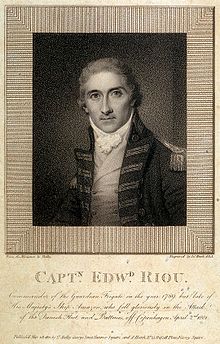
HMS Sirius was a 36-gun fifth-rate frigate of the Royal Navy. Between 1797 and 1805, the Sirius was engaged in maintaining the blockade of Napoleonic Europe. She was lost in 1810 when her crew scuttled her after she grounded during the Battle of Grand Port.

Edward Riou FRS was an officer of the Royal Navy who served during the French Revolutionary Wars under several of the most distinguished naval officers of his age and won fame and honour for two incidents in particular.

HMS Endymion was a 40-gun fifth rate that served in the French Revolutionary Wars, the Napoleonic Wars, the War of 1812 and during the First Opium War. She was built to the lines of the French prize Pomone captured in 1794. Due to her exceptional handling and sailing properties, the Severn-class frigates were built to her lines, although the gunports were rearranged to mount an extra pair of guns per side, the ships were made of softwood and were not built until nearly the end of the Napoleonic Wars.

Révolutionnaire, was a 40-gun Seine-class frigate of the French Navy, launched in May 1794. The British captured her in October 1794 and she went on to serve with the Royal Navy until she was broken up in 1822. During this service Revolutionnaire took part in numerous actions, including three for which the Admiralty would in 1847 award clasps to the Naval General Service Medal, and captured several privateers and merchant vessels.
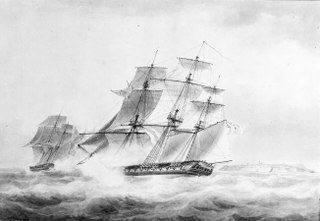
HMS Phoenix was a 36-gun Perseverance-class fifth-rate frigate of the Royal Navy. The shipbuilder George Parsons built her at Bursledon and launched her on 15 July 1783. She served in the French Revolutionary and Napoleonic Wars and was instrumental in the events leading up to the battle of Trafalgar. Phoenix was involved in several single-ship actions, the most notable occurring on 10 August 1805 when she captured the French frigate Didon, which was more heavily armed than her. She was wrecked, without loss of life, off Smyrna in 1816.
Vice-Admiral Lord Henry Paulet KCB was an officer in the Royal Navy who saw service in the American War of Independence, the French Revolutionary and Napoleonic Wars. Born into the British nobility as a younger son of the Marquess of Winchester, he rose through the ranks and had gained his own command by the early stages of the French Revolutionary Wars. He was involved in a number of famous engagements during his career, such as the capture of the French frigate Gloire in 1795, though he narrowly missed out on seeing direct action at two of the most significant naval battles of the wars with the French. The first was the Battle of Cape St Vincent, where he had left Jervis's fleet a few days previously, the second was the Battle of Copenhagen, where he remained with Sir Hyde Parker's reserve squadron. He nevertheless rose through the ranks to reach vice-admiral, despite an incident that saw him court-martialled and dismissed, only to be reinstated by the intervention of the King; and a tendency to eccentricity. He married towards the end of the wars with France, and had several children. Paulet served as one of the Lords Commissioners of the Admiralty from 1813, and was installed as a Knight Commander of the Bath in 1815, but ill-health forced his retirement from active service shortly afterwards, and he would die of cancer in 1832.
HMS Alcmene was a 32-gun Alcmene-class fifth rate of the Royal Navy. This frigate served during the French Revolutionary and Napoleonic Wars under the command of several notable officers. Alcmene was active in several theatres of the war, spending most of her time cruising in search of enemy vessels or privateers, and escorting convoys. She fought at the Battle of Copenhagen in 1801 and served in the blockade of the French coasts during the later Napoleonic Wars until she was wrecked on the French coast in 1809.

HMS Romulus was a 36-gun fifth rate frigate of the Flora class, built for the Royal Navy and launched in September 1785. At the outbreak of the French Revolutionary War, Romulus was despatched to the Mediterranean where she joined a fleet under Admiral Lord Hood, initially blockading, and later occupying, the port of Toulon. She played an active role during the withdrawal in December, providing covering fire while HMS Robust and HMS Leviathan removed allied troops from the waterfront.

HMS Triton was a 32-gun fifth-rate frigate of the Royal Navy designed by James Gambier and launched in 1796 at Deptford. Triton was an experimental ship and the only one built to that design; she was constructed out of fir due to wartime supply shortages of more traditional materials and had some unusual features such as no tumblehome. Her namesake was the Greek god Triton, a god of the sea. She was commissioned in June 1796 under Captain John Gore, with whom she would spend the majority of her active service, to serve in the Channel in the squadron of Sir John Warren.

HMS Caroline was a 36-gun fifth-rate Phoebe-class frigate of the Royal Navy. She was designed by Sir John Henslow and launched in 1795 at Rotherhithe by John Randall. Caroline was a lengthened copy of HMS Inconstant with improved speed but more instability. The frigate was commissioned in July 1795 under Captain William Luke to serve in the North Sea Fleet of Admiral Adam Duncan. Caroline spent less than a year in the North Sea before being transferred to the Lisbon Station. Here she was tasked to hunt down or interdict French shipping while protecting British merchant ships, with service taking her from off Lisbon to Cadiz and into the Mediterranean Sea. In 1799 the ship assisted in the tracking of the French fleet of Admiral Étienne Eustache Bruix, and in 1800 she participated in the blockade of Cadiz.
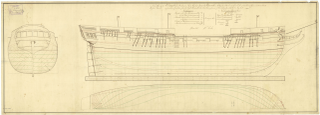
The Thames-class frigate was a 32-gun fifth-rate frigate class of eight ships of the Royal Navy based on the Richmond-class frigate designed by William Bately. The ships were ordered to the older design, which was of a smaller type of ship compared to more modern designs, so that they could be built quickly and cheaply in time to assist in defending against Napoleon's expected invasion of Britain. The class received several design changes to the Richmond class, being built of fir instead of oak, with these changes making the class generally slower and less weatherly than their predecessors, especially when in heavy weather conditions. The first two ships of the class, Pallas and Circe, were ordered on 16 March 1804 with two more ordered on 1 May and the final four on 12 July. The final ship of the class, Medea, was cancelled on 22 October before construction could begin but the other seven ships of the class were commissioned between 1804 and 1806.

HMS Jason was a 36-gun fifth-rate Penelope-class frigate, launched in 1800. She served the entirety of her career in the English Channel, mostly in the frigate squadron of Commodore Charles Cunningham. Serving off the coast of France, especially around Le Havre and Cherbourg, she captured several French privateers and recaptured a British merchant ship in a cutting out expedition. Having only been in commission for around fifteen months, Jason was wrecked off the coast of St Malo on 21 July 1801. Her crew were saved and later exchanged, and in August her wreck was burned to prevent the French from rescuing it.

HMS Beaulieu was a 40-gun fifth-rate frigate of the Royal Navy. The ship was laid down in 1790 as a speculative build by the shipwright Henry Adams and purchased by the Royal Navy in June of the same year. Built to the dimensions of a merchant ship, Beaulieu was broader, with more storage capacity, than a standard frigate; though may not have had good sailing qualities. The frigate was commissioned in January 1793 by Lord Northesk and sent to serve on the Leeward Islands Station. She participated in the capture of Martinique in February 1794, and then was similarly present at the capture of the island of Saint Lucia in April. The frigate also took part in the initial stages of the invasion of Guadeloupe. Later in the year the ship's crew was beset by yellow fever and much depleted. Beaulieu was sent to serve on the North America Station to allow them to recuperate, returning to the Leeward Islands in 1795. In the following two years the ship found success in prizetaking and briefly took part in more operations at Saint Lucia. She returned to Britain at the end of 1796.
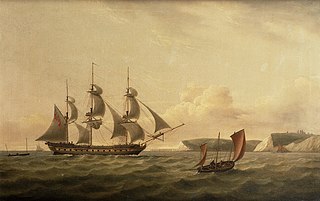
HMS Hussar was a 38-gun fifth-rate Amazon-class frigate of the Royal Navy. Launched at the end of 1799, the entirety of the frigate's career was spent serving in the English Channel and off the coast of Spain. Hussar primarily served as a convoy escort and cruiser, in which occupation the frigate took several prizes, including the French privateer Le General Bessieres. Towards the end of 1803 Hussar was sent to serve in Sir Edward Pellew's Ferrol squadron. On 8 February 1804 Hussar was returning to England with dispatches when the ship was wrecked off the coast of Île de Sein. The crew attempted to sail for home in a fleet of commandeered boats, but the majority were forced to go into Brest to avoid sinking in bad weather, where they were made prisoners of war.

The Perseverance-class frigate was a 36-gun, later 42-gun, 18-pounder fifth-rate frigate class of twelve ships of the Royal Navy, constructed in two batches. Designed by Surveyor of the Navy Sir Edward Hunt the first iteration, consisting of four ships, was constructed as a rival to the similar Flora-class frigate. Strongly built ships, the Perseverance class provided favourable gunnery characteristics and was highly manoeuvrable, but bought these traits with a loss of speed. The name ship of the class, Perseverance, was ordered in 1779 and participated in the American Revolutionary War, but her three sister ships were constructed too late to take part. The class continued in service after the war, but soon became outdated.

HMS Resistance was a 36-gun fifth-rate Aigle-class frigate of the Royal Navy, one of a pair designed by Sir John Henslow. Resistance was commissioned in May 1801 by Captain Henry Digby, and after brief service in the English Channel the frigate left for Quebec in charge of a convoy. While on voyage Resistance captured the French privateer Elizabeth, which was the last ship captured during the French Revolutionary War. Having returned to England at the end of the year, the frigate resumed service in the English Channel, with Captain Philip Wodehouse replacing Digby. On 31 May 1803 Resistance was sailing to the Mediterranean Sea when she was wrecked off Cape St. Vincent; the crew survived.

The Narcissus-class frigate was a 32-gun, 18-pounder fifth-rate frigate class of five ships of the Royal Navy. Designed by Surveyor of the Navy Sir John Henslow, the class was created to make use of shipyards that could not construct larger frigates. They were similar in design to the preceding 32-gun frigate class, the Amphion class, but were slightly shorter. Two ships were initially constructed, with a later batch of three being ordered in response to an Admiralty request for the resumption of production of proven frigate designs. The final two ships of the class were cancelled when the shipyard they were being constructed at went bankrupt. Unlike her sister ships, the name ship of the class Narcissus was armed with experimental short 24 pounders rather than 18 pounders.
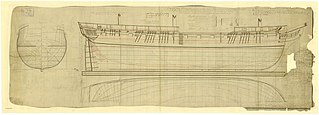
HMS Blanche was a 36-gun fifth-rate Apollo-class frigate of the Royal Navy. She was commissioned in 1800 by Captain Graham Hamond, under whom on 2 April 1801 Blanche fought as part of the frigate reserve at the Battle of Copenhagen. She spent the remainder of the French Revolutionary Wars serving in the English Channel. When the Napoleonic Wars began in 1803 Blanche was sent to serve in the West Indies under the command of Captain Zachary Mudge. There the frigate participated in the Blockade of Saint-Domingue and an unsuccessful invasion of Curacao, capturing upwards of twenty-four vessels.

HMS Trent was a fifth-rate sailing frigate of 36 guns, built for the Royal Navy and launched in February 1796. She carried a main battery of twenty-six 18-pounder (8.2-kilogram) long guns. She and her sister ship HMS Glenmore were constructed from pitch pine rather than oak.

The Amazon-class frigates of 1795 were a set of four 36-gun sailing frigates built for the Royal Navy and designed by William Rule. The first pair were constructed from oak and launched in July 1795. A second pair had already been ordered in January that year, to be made from pitch pine, one launched in February and the other in March of 1796. All four of the new class carried a main battery of twenty-six 18-pounder (8.2 kg) long guns supplemented with eight 32-pounder (15 kg) carronades and ten long guns, 9-pounder (4.1 kg) for the first pair, 12-pounder (5.4 kg) for the second batch, on the upperworks.


